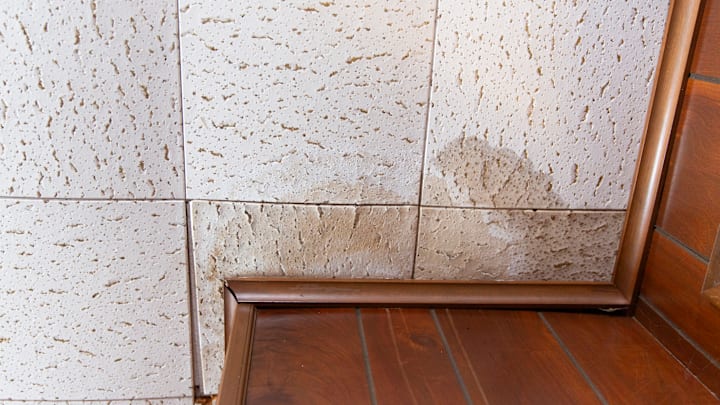One surefire way to disappoint houseguests or prospective home buyers is to have a water stain on your ceiling. These brown, patchy spots come from dried mineral deposits, and are a red flag that something is up with your roof or your plumbing.
While the problem may be resolved, the unsightly water stains left behind still need some attention, too. Fortunately, there are ways to get rid of them without any major renovations.
- What Are the Best Ways To Clean Water Stains?
- What To Do if You Have Ceiling Damage From Water Stains
What Are the Best Ways To Clean Water Stains?
One easy way to get rid of water stains is to use the catch-all cleaner, bleach, to attack the stain. A solvent can be made with one cup of bleach and three parts water. (Do not mix bleach with any other chemical or cleaner, as the resulting fumes could be highly dangerous.) Using a spray bottle or sponge, get the solution on the stain, but only after you’ve laid down a drop cloth to catch any drips. Be sure to wipe with clean water, too.
The purpose of the bleach isn’t to remove the stain, which is likely embedded in the plaster or paint. It’s to kill any mildew and prepare the surface to paint over the blemish. Wait at least 24 hours and then apply a stain-blocking primer like Kilz, which is designed to prevent built-in stains from bleeding through paint over time. Top that with the color of your choice.
The bad news: It can be difficult to find an exact paint color match, so if you find your newer paint is sticking out, blending in your paint job may involve repainting the entire ceiling.
What To Do if You Have Ceiling Damage From Water Stains
If the stain led to cracks in the plaster, you’ll need to repair that before painting. Repair kits, available at most home improvement stores, provide tools for scraping away loose paint or drywall and then filling the gaps with putty, which can then be smoothed out.
The most important thing when dealing with it is finding what caused the water stain in the first place. Before painting, make sure you’ve addressed the source of the leak and made the necessary repairs. Old pipes, radiators, high humidity, and damaged roofs are the most likely culprits.
Read More Live Smarter Stories:
A version of this story was originally published in 2022 and has been updated for 2025.
